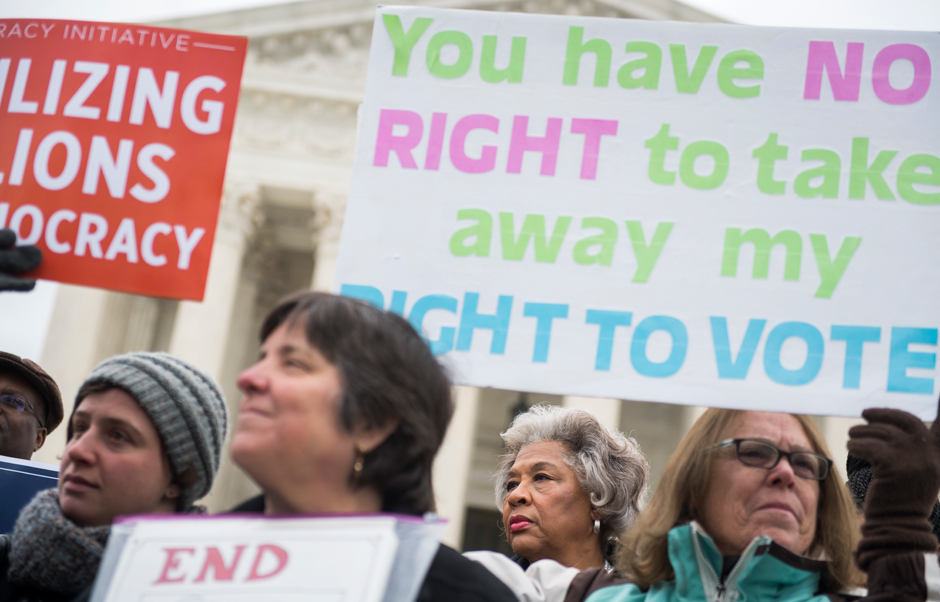
WASHINGTON—By a 5-4 vote, the U.S. Supreme Court blew another hole in voting rights today, saying Ohio—and other states—could throw voters off the rolls strictly because they don’t vote, or don’t respond to a mailing warning them they’re about to be tossed.
The decision involved a Cleveland voter, Navy veteran Larry Harmon, who found out in 2015 he had been thrown off the rolls while serving overseas. A community group in the city and the AFL-CIO’s A. Philip Randolph Institute went to bat with him. They all challenged the GOP-run legislature’s law permitting such evictions.
Ohio Secretary of State Jon Husted, a Republican, tossed Harmon and thousands of others. Husted defended the law. He won. Justice Samuel Alito’s ruling for the court majority clears the way for Ohio and any other state to toss voters off the rolls wholesale, the dissenters said. Indeed, Alito wrote, federal law makes such evictions—after notice goes out and no response comes back—mandatory.
That’s going to hurt minorities and low-income voters in particular, Justice Sonia Sotomayor said in one of the two dissents. She joined the other Democratic-named justices in the entire dissent, but Sotomayor wanted to discuss the practical impact. The Republican-named justices never addressed that.
“Congress enacted the National Voter Registration Act against the backdrop of substantial efforts by states to disenfranchise low-income and minority voters, including programs that purged eligible voters because they failed to vote in prior elections,” Sotomayor said.
“Concerted state efforts to prevent minorities from voting and to undermine the efficacy of their votes are an unfortunate feature of our country’s history,” Sotomayor, who is of Puerto Rican descent, stated.
Alito’s ruling “contradicts the essential purposes of the law, ultimately sanctioning the very purging Congress sought to protect against,” Sotomayor wrote. Rank-and-file Ohio unionists agreed with her.
“The stuff the Ohio legislature is doing—gerrymandering and this case—doesn’t help us in the labor movement and doesn’t look good for the Democratic Party,” said Adam Dombroff, chair of the Toth Industries unit of United Auto Workers Local 12 in Toledo, interviewed during the UAW convention in Detroit. “We have to do more to get people registered and more active.”
“And some people don’t vote except for the presidential years,” added Dave Appenfelder, a shop steward at Mobis North America in Toledo.
The impact of the ruling could be enormously dangerous to the right to vote, and not just for minorities. Alito’s ruling upholds the Ohio law which lets the state to send out “final warning” notices to voters who fail to cast ballots in the prior two years—just one election cycle. If the voters don’t respond, they get tossed after a second cycle. Several other states have approved similar laws.
“We have no authority to dismiss the considered judgement of Congress and of the Ohio legislature regarding the value of a registrant’s failure to send back a return card,” telling the state whether they’ve moved or not.
The main dissenter, Justice Stephen Breyer, pointed out that after the 2012 election, Ohio’s Republican Secretary of State mailed notices to 1.5 million registered voters, with return receipt postcards, telling them they would be thrown off the rolls unless they responded. They hadn’t voted in 2010. That was about one-fifth of the Buckeye State’s electorate.
“But more often than not, the state fails to receive anything back,” Breyer said. And that “proves nothing at all.”
That’s what happened after the 2012 mailing, Breyer noted: 60,000 voters “returned the cards saying, in effect, ‘You’re right, I moved.’ About 235,000 returned cards saying ‘You are wrong, Ohio. I have not moved.’ In the end, there were more than 1 million notices—the vast majority—to which Ohio received no return card at all.” (The italics are his.)
“What about those registered voters?” Breyer asked. “Is there any reason at all, other than their failure to vote, to think they moved? The answer to this question must be ‘no.’” And he noted 59 percent of Ohio voters didn’t vote in the state’s 2014 off-year election.
Ohio’s law, and those passed elsewhere, assume voters who didn’t respond moved, and the states can throw them off the rolls after another election cycle. Breyer said that’s ridiculous. “The streets of Ohio’s cities are not filled with moving vans,” he deadpanned.
“Ohio’s system…adds a factor that has no tendency to reveal accurately whether a registered voter has changed residences. Nothing plus one is still one. And if that ‘one’ consists of a failure to vote, then Ohio’s program fails to make ‘a reasonable effort’ to comply with” voting laws, Breyer said.
“They’re doing more and more to get people off the rolls,” Local 12 health and safety official Dominic Wahl said of the state’s politicians. The solution to such problems “is to push on the millennials and Generation X” to register and vote, added Benjamin Taylor, president of Local 913 in Sandusky. And grandparents talking to their grandchildren is the best way to achieve that goal, he added.









